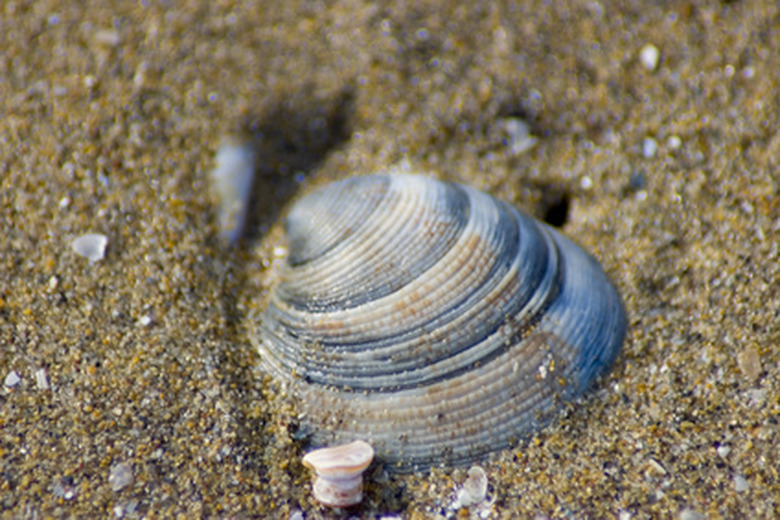How Do Clams Produce Their Shells?
When you picture a clam, you likely imagine a rounded creature with two hard shells protecting it. You might also think of butter, fresh lemon and a tasty seafood dish. Though adult clams might vary in size and shape, they all have a similar appearance and the same characteristic of two shell halves held together by a pair of valves. However, did you know that baby clams don't have a shell at all? Where do clam shells come from and how do clams grow their shells?
About the Bivalve Group
About the Bivalve Group
Clams are members of the class Bivalvia. Members of this class of molluscs get their name from their bivalve shell, or shell with two halves connected by two valves. Many different species of bivalves exist in this group, including clams, oysters, mussels and scallops. Some species of molluscs in this class permanently affix themselves to a surface, like oysters. Other bivalve species move freely in the sediment, like clams, or even in open water.
The Clam Life Cycle
The Clam Life Cycle
How are clams born? Clams reproduce through spawning, where males and females release their sperm and eggs into the water to reproduce externally. Once fertilized, these develop into free-swimming larvae which otherwise look like microscopic versions of adults. As they reach maturity, they move to the seafloor and prepare to metamorphose into their adult form.
How Do Clams Grow Their Shells?
How Do Clams Grow Their Shells?
The inner portion of a clam's shell has a layer known as the mantle. The layers of the shell grow from the mantle and continue to grow every year as the clam ages. Some clams live and grow for many years while others have shorter lifespans. The mantle uses a two-fold process to produce the shell. First it creates a layer of protein, and then it overlays minerals on the protein base to create the hard exterior of the shell.
What Are Clam Shells Made Of?
What Are Clam Shells Made Of?
A clam seashell has a shell consisting primarily of calcium carbonate exuded by the mantle. Clams obtain this calcium carbonate from the water around them. You might notice that a clam shell does not have a smooth surface, but rough ridges along the top. Researchers refer to these ridges as rings or umbones and they serve a similar purpose to the rings of a tree.
Each year, clams produce more shell surface during the spring and summer when food is plentiful. But as winter rolls around and food becomes scarce they cease shell-making until conditions are more favorable. This results in yearly checks, or regions where the shell doesn't grow as thick. Researchers can use these checks to estimate how old a clam is, though they don't provide an exact estimate as temperature, species and region of growth can impact the rings.
Pollution and Clam Shell Growth
Pollution and Clam Shell Growth
Clams, and all creatures that grow similar calcium carbonate shells, face a unique threat from pollution. Pollution causes the pH levels of ocean water to drop, resulting in more acidic water. Researchers call this process ocean acidification. When ocean acidification occurs, the acidity causes the calcium carbonate shells to disintegrate.
Some creatures cannot survive this change and die, as we see with large areas of coral bleaching. Even those that do survive must work overtime to compensate for the shell loss, wasting precious energy. This means that the surviving organisms do not reach the same sizes or have the same disease resistance as those prior to the effects of ocean acidification.
Humans rely on a large number of molluscs potentially impacted by ocean acidification, including clams, oysters, mussels, crabs, shrimp and lobsters. Acidification also impacts other commercially important species indirectly by harming their food supply of plankton and microorganisms.
References
- University of California Museum of Paleontology: The Bivalvia
- The Living World of Molluscs: Mussels and Clams (Bivalvia)
- Food and Agricultural Organization of the United Nations: The Hatchery Culture of Bivalves
- The Conversation: How Do Shells Get Made?
- Natural History Museum: How Does Ocean Acidification Affect Marine Life?
Cite This Article
MLA
Zinni, Yasmin. "How Do Clams Produce Their Shells?" sciencing.com, https://www.sciencing.com/how-do-clams-produce-their-shells-13404494/. 30 September 2021.
APA
Zinni, Yasmin. (2021, September 30). How Do Clams Produce Their Shells?. sciencing.com. Retrieved from https://www.sciencing.com/how-do-clams-produce-their-shells-13404494/
Chicago
Zinni, Yasmin. How Do Clams Produce Their Shells? last modified March 24, 2022. https://www.sciencing.com/how-do-clams-produce-their-shells-13404494/
